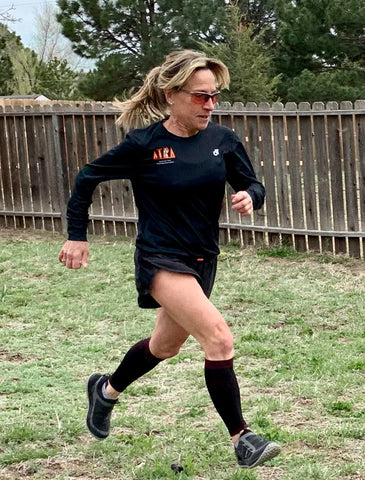As we launch the new Run Across America blog, we're excited to share a guest post by Darren Lancaster, co-founder and CEO of our partner GO Sleeves. We asked Darren what tips he had on recovery and injury prevention. He reached out to Nancy Hobbs, founder of the American Trail Running Association to have a conversation on how she keeps moving. Here's Darren:
I’m honored to write this post for the Run Across America blog, and even more honored to partner with a super accomplished competitive runner to help you STAY RUNNING! We couldn’t think of a more valuable topic than how to improve your workout recovery strategies to stay healthy, active and moving.
Meet Nancy Hobbs from the American Trail Running Association
I am joined by Nancy Hobbs, founder of the American Trail Running Association (ATRA), chairperson for USA Track & Field's Mountain Ultra Trail Running Council and World Mountain Running Association council member. In 1995 Nancy organized the first women’s team for the World Mountain Running Championships. Nancy is a serious Master runner who competes in trail and mountain competitions around the globe. Her favorite distance to run is 5K (join her in the Run Across America on June 12!) and she runs and cross-trains 7 days a week.

Nancy Hobbs in her element!
Nancy’s active and intentional recovery practices
An active and intentional recovery means going beyond merely giving your body a “timeout” rest day and applying products. Your mind and body are partners in this process, working together in a very thoughtful, intentional, and iterative manner. Your focus is on being pain and injury-free for each and every running workout by listening and assessing the weaknesses in your body and engaging in iterative improvement through active recovery practices. In other words, you’re on top of your game for every run!
To keep things simple for you, Nancy offers the following recovery practices as a starting point that makes sense for all runners:
-
Engage in secondary activities as part of your recovery process: Nancy leverages indoor cycling, ElliptiGO MSUB (Mountain Stand Up Bike) workouts, swim walking/running, foam rolling and slant boards as part of her active recovery practice. These are lighter-impact activities that activate the key muscles, ligaments and tendons used in running while also improving balance and strength.
Nancy also utilizes GO Kinesiology Calf Sleeves in her active recovery process, at times for 5-6 hours per day while engaging in secondary activities and while resting. The kinesiology strips built into GO Sleeves activate the body’s active recovery capabilities by accelerating blood and lymphatic flow to key ligaments, tendons and muscles resulting in an acceleration of recovery from lactic acid build-up.

Active Recovery with GO Kinesiology Sleeves -
Focus on areas of tightness: intention is again the key. You’re taking an active role in assessing where your body is vulnerable. It’s a good bet that if you’re running regularly, you’ll find areas in your heels, Achilles' tendons, calf muscles or shin splints where flexibility could be improved. Given the interconnectedness of our bodies, we frequently find that tightness in a calf or Achilles will show up as an injury in the foot, such as plantar fasciitis.
For leg issues many runners can leverage “self-massage” through foam rollers, percussion massagers or seek professional massage and physical therapy. The therapeutic support provided by GO Kinesiology Sleeves is another mechanism that Nancy uses whenever she feels any tightness or “tweaks”.
Many of us also experience back and core issues which typically must be addressed with a combination of professional help and activities that increase core strength and flexibility. As a reminder, based on the interconnectedness of our bodies, back soreness can be exacerbated or caused by tightness in the hips or legs. Activities that can help those of us with back tightness include yoga (I particularly recommend hot, or Bikram yoga for flexibility), core strengthening exercises and stretching.
-
Slow down and listen to your body: we live busy lives. It’s hard to find the time to slow down and pay attention to our body. And yet, every day our bodies are talking to us and trying to tell us what they need. It requires slowing down and being willing to invest your time and energy in taking care of the body that takes care of you. If you’re able to invest in professional massage or physical therapy, you will find that you can provide a roadmap to help these professionals focus their attention on your body to maximize your improvements.
Nancy and I look forward to sharing more of her expert running practices and tips with you in the future. In the meantime, if you’re looking for help from a running community, please contact the American Trail Running Association or GO Sleeves. The GO Sleeves team in the Run Across America app is a great way to get in touch; just use team code GOSLEEVES in app or register at this link. Thanks to Nancy for the tips, and to Run Across America for the space to share them.
Darren Lancaster is the CEO of GO Sleeves. GO Sleeves was born out of necessity when Darren and co-founder Roy Carrillo got tired of physical breakdowns that weren’t being addressed by sleeves, braces, KT Tape and even pain meds. Together they are on a mission to help people stay active, achieve peak performance, and live a life that’s virtually free from being sabotaged by pain and discomfort.


2 comments
Thank you for sharing Nancy’s sage advice. The workout is only half of the equation to fitness and competitive running, rest and recovery is the other 50%, but we tend to not pay enough attention to it.
Good info to stay active and competitive. Thank you, Darren and Nancy!